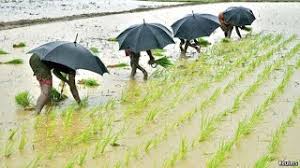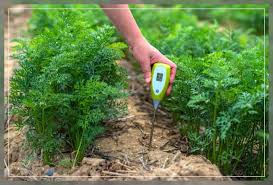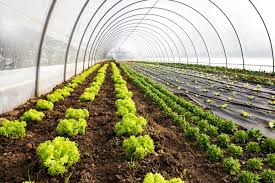Climate, especially rainfall, is one of the three most important aspects of the physical environment that significantly influences Nigerian agriculture. Climatic factors like rainfall and temperature show seasonal variations, which are not only essential in determining cropping patterns and systems but also play a vital role in deciding the length of the growing season.
In addition to the influence of climate on the occurrence of rainfall and crop physiological growth, these factors ultimately determine the magnitude of crop yields across the different ecological zones in Nigeria.
Read Also: Types of Fungi Reproduction
Rainfall

Rainfall is the most important climatic variable, having a far-reaching impact on agricultural crop production. It plays a crucial role in agricultural production by:
i. Providing the main source of moisture to the soil, necessary for the activation of plant growth.
ii. Replenishing water in rivers to facilitate irrigation operations.
iii. Contributing to the build-up of underground water reserves, which can later be tapped by wells in dry areas through seepage and percolation.
iv. Influencing the soil/water/plant relationship, where soil moisture is directly relevant to plant growth based on the water balance (total rainfall minus runoff and evapotranspiration).
The amount, incidence, variation, and reliability of rainfall determine differences in cropping patterns in various ecological zones in Nigeria. Rainfall patterns in Nigeria follow a south-to-north gradation in amount, with interruptions only around Jos Plateau, Mambila Plateau, and the foothills of the Cameroon mountains. Two broad cropping patterns can be defined based on rainfall variation:
i. The perennial tree and root-crop zone in the wetter southern region.
ii. The seasonal grain and pulse crop zone in the drier northern region.
Effects of Excessive Rainfall
Excessive rainfall (where the total rainfall exceeds 2540 mm per year in the southern region) adversely affects crop production. The negative impacts include:
i. High run-off and soil erosion (a serious effect globally).
ii. Leaching and nutrient loss.
iii. Waterlogging.
iv. Vigorous vegetative growth or increased weed infestation.
v. General disruption of agricultural activities.
Effects of Inadequate Rainfall
Inadequate rainfall (where total rainfall is less than 101.6 mm per year in the northern region) makes crop growth impossible for most of the year unless irrigation is employed.
Seasonality, duration, and the regimes of the wet season, along with the number of months of inadequate rainfall, are more crucial to agricultural activities than the total rainfall.
As a result, crop growth is only sustainable for varying periods in different ecological zones throughout the year, largely in response to alternating wet and dry seasons of varying durations.
The number of months with 1016 mm rainfall ranges from 3-5 months south of the Rivers Niger and Benue to more than 9 months in the northern part of Borno State (dry areas, i.e., Sahel savanna zone).
Impact of Rainfall on Planting Operations and Crop Selection
The onset of rains, regime, and duration of wet seepage across ecological zones significantly influence the timing of planting operations, the types of crops grown, and seed germination and seedling growth. These conditions account for:
i. The suitability of perennial tree crops (e.g., cocoa, oil palm) and food crops with long growing periods (e.g., white yam, cassava) in most parts of the forest zone, which experiences rainfall for 250 or more days.
ii. The possibility of growing two consecutive or alternating crops in a year (e.g., maize and cowpea).
iii. The cultivation of vegetable crops, such as melon and pumpkin.
iv. The predominance of short-season crops, especially cereals like guinea-corn and millet, in the northern savanna zones, where rain falls for 80-200 days.
Variation in Wet Season Duration and Crop Diversity
The duration of the wet season influences the variety of crops grown in different zones. For instance, perennial crops like cocoa, kolanut, and oil palm thrive in the forest zone, where rainfall occurs for 250 days or more, depending on soil fertility status.
In areas receiving more than 250 days of rain, crops like rubber and oil palm are particularly important, and the region is well-suited for food crops with long growing periods, such as white yam, and crops with high rainfall requirements, such as rice and cocoyam.
Additionally, two consecutive crops per year are possible (e.g., maize and cowpea). In the forest zone, the duration of rainfall is also critical for growing certain vegetables, such as melon and pumpkin.
Moving northward to the savanna zone, where the wet season lasts 100-200 days, cereals and export crops with short maturity periods (e.g., guinea-corn and millet) are dominant.
Onset of Rains Across Ecological Zones
The onset of rains varies across ecological zones:
i. March in the interior part of southern Nigeria.
ii. April in most parts of the Middle Belt.
iii. May/June in the Sudan zone.
This variation has significant implications for crop cultivation, especially in drought-prone areas that mark the northern limit of arable agriculture.
Regional and Seasonal Rainfall Features and Their Agricultural Effects
There are distinct regional and seasonal rainfall patterns across Nigeria that affect soil/water/crop relationships. Every region experiences water deficits, ranging from a few weeks in the south to several months in the north.
Alongside the relatively short duration of rainfall (80% of rainfall occurs within the first 30 minutes) and high annual evapotranspiration losses (1000 mm), this depletes the water balance further, making irrigation necessary on farmlands in certain regions of Nigeria.
In the southern region, irrigation is supported by sinking wells and harvesting run-off water from smaller streams. In contrast, the northern region faces considerable water shortages, limiting the water supply for large irrigation projects, except in parts of the Middle Belt.
Adaptation Strategies for Water Deficit in the Northern Region
Farmers in the northern region have developed adaptation strategies to cope with the distinct water cycles, including:
i. Planting fields with high moisture status to match the moisture deficit at the onset of rains, followed by fields with higher deficits later in the season.
ii. Utilizing soil moisture between the end of the rains and the end of the growing season, as the end of the rains coincides with the flowering of cotton, bud maturation of groundnut, and heading of guinea-corn. The success of cereal crops in the north depends on how well water demands align with the seasonal patterns of water availability.
Severe droughts, especially in the northern region, lead to declines in the amount of cultivated land, reductions in crop yield, and a decrease in available food and export crops.
Temperature and Its Impact on Crop Production

Temperature is a major factor that limits the distribution of plants and animals globally. It plays a secondary role in influencing evapotranspiration, photosynthesis, and soil warming. The effects of temperature on farming systems include:
i. Rapid decomposition of soil organic matter (SOM) due to increased microbial activities and biochemical reactions.
ii. High temperatures render built-in fallows ineffective.
iii. High temperatures promote the incidence of pathogens and pests.
iv. High night temperatures increase respiratory rates, depleting plant assimilates and leading to low net accumulation and poor crop yield.
v. Influence on critical plant processes such as seed germination, pollination, flowering, fruiting, ion uptake, leaf growth, and cell enlargement.
In Nigeria, air temperature is not a limiting factor for crop growth. However, regional and seasonal temperature variations are locally important to agriculture.
The higher mean annual temperature in the north promotes higher evapotranspiration, reducing the water balance. In the Sudan and Sahel zones, higher temperatures accelerate water evaporation from rivers and lakes, depleting water resources necessary for irrigation.
On the other hand, higher night temperatures in the forest zone lower potential photosynthesis, affecting crop productivity in various zones. Soil temperature is more critical for plant growth than air temperature.
For instance, the optimal soil temperature for potato tuber growth is 17°C, with no growth at temperatures above 29°C. Notable temperature characteristics in Nigeria include:
i. Higher inland day temperatures, except in highland areas.
ii. Increasing diurnal temperature range with distance from the sea, especially in the north.
iii. Lower mean daily temperatures in January (the peak of the dry season) as one moves northward.
Farmers have adapted to these challenges through early crop harvesting, mixed cropping, mulching, minimizing runoff/erosion, maintaining organic matter through decaying residues, high nutrient supply, suppression of weed growth, and shading soil to protect crops.
Read Also: Life Cycles and Alternation of Generations in Phytophthora and Rhizopus
Solar Radiation and Its Role in Crop Production

Solar radiation plays a key role in determining agricultural productivity by influencing surface reflectivity, net radiation, and dry matter production. During photosynthesis, plants use visible light to convert water and CO2 into dry matter, making solar radiation essential for yield.
Crop dry matter production depends on the level of incoming solar radiation and the type of plant utilizing it under favorable conditions. Solar radiation is particularly important for final yields in crops grown in regions with adequate water supply, such as sugarcane and lowland rice.
Relative Humidity and Its Agricultural Impacts
Relative humidity is the ratio of actual water vapor in the air to the maximum amount it can hold at a given temperature, serving as a measure of atmospheric dampness. In West Africa, variations in relative humidity have a more significant impact on the climate than high temperatures.
Coastal areas experience higher relative humidity, often reaching up to 100%, especially during the dry season. High relative humidity can increase disease incidence in crops and reduce their ability to capture solar radiation.
In contrast, low relative humidity can cause high evapotranspiration and wilting in crops due to excessive water loss. Nigerian farmers have developed strategies such as varying stand geometry and adjusting leaf arrangements to maximize light interception, adapting crops to local relative humidity conditions.
Daylength (Photoperiod) and Its Effect on Crop Growth
Daylength, or photoperiod, refers to the number of daylight hours in a day. It varies with the apparent movement of the sun across the northern and southern hemispheres, influencing wind patterns and rainfall.
Daylength affects key agricultural processes such as flowering, tuber formation, vegetative growth, seed germination, and the timing of agricultural operations like planting and harvesting. Crops are categorized based on photoperiod sensitivity into three groups:
i. Long-day plants (those that flower when exposed to more than 14 hours of daylight, e.g., Irish potato, wheat, barley, oat).
ii. Short-day plants (those that flower when exposed to less than 10 hours of daylight, e.g., sweet potato, maize, soybean).
iii. Day-neutral plants (those unaffected by daylength, e.g., cowpea).
Most tropical crops are highly sensitive to daylength and fall into two groups:
i. Those with a critical daylength of less than or equal to 12 1/4 hours (e.g., Corchorus olitorius).
ii. Those with a critical daylength of more than or equal to 12 1/4 hours (e.g., Phaseolus lunatus).
Winds and Ocean Currents in Relation to Crop Production
Winds and ocean currents significantly influence rainfall and the duration of the rainy season. In West Africa, two predominant air masses dominate:
i. The equatorial maritime air mass, characterized by moisture-laden southwest monsoon (SWM) winds.
ii. The tropical continental air mass, characterized by dry, dusty northeast trade/harmattan (NET) winds.
The meeting point of these two air masses is called the Inter-Tropical Front (ITF). The northward movement of the ITF brings rain, while its southward movement brings harmattan. In February, the NET retreats, and the SWM advances, reaching most areas south of latitude 20°N by July, leading to widespread rainfall.
In August, the ITF reaches its northern limit before retreating coastward. By January, the ITF is near the coast again, and the NET becomes dominant once more. Other winds, such as sea breezes, land breezes, and ocean currents, also impact agricultural production. The three main ocean currents in the region are:
i. The Cold Benguela Current.
ii. The Guinea Counter Current.
iii. The Cool Canary Current.
Winds blowing over warm currents carry moisture, while those over cold currents have a cooling effect, which often results in fog instead of rain along the coast.
These climatic factors, especially rainfall and temperature, directly influence crop productivity and the sustainable food supply in Nigeria.
Do you have any questions, suggestions, or contributions? If so, please feel free to use the comment box below to share your thoughts. We also encourage you to kindly share this information with others who might benefit from it. Since we can’t reach everyone at once, we truly appreciate your help in spreading the word. Thank you so much for your support and for sharing!
